The Planes of Movement
and a list of anatomical directions
Graphics by Morgan Jeske ©2014
By Bernie Clark, April 13th, 2014
A map is a handy device for navigating around unfamiliar landmarks, and to be able to use a map, we also need to know the cardinal directions: to know where north is, for example. Normally a map is a two-dimensional representation of space, but to navigate within our bodies, it is better to employ a three-dimensional representation. A 3-D map will help us in understanding how yoga postures move our bodies, and how our unique skeletal variations affect those movements.
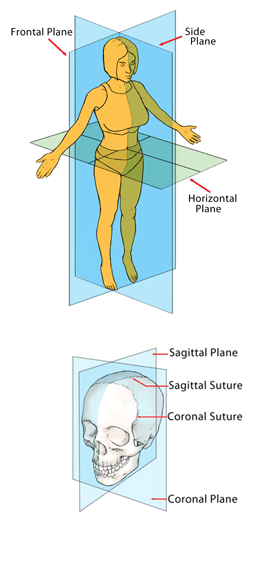 The Planes of Movement:
The Planes of Movement:
Here you see an image of a person shown in three-dimensional space. Anatomists have found it useful to describe the body in these 3D planes, but they confusingly use several different descriptions. We will use the simple terms frontal plane, side plane and horizontal plane. The side plane is technically called the sagittal plane because it follows a line on the cranium called the sagittal suture, which goes from about the middle of the skull to the back of the skull. The frontal plane is called the coronal plane because of a line that goes from one side of the skull to the other, called the coronal suture. The horizontal plane is also called the transverse plane, and sometimes it is called the axial or the transaxial plane.
As we will see, life is not as simple as pure movement in three planes, because in our daily life we move in multiple planes at once: we do not just move back and forth or side-to-side, we combine these movements.
The Directions Within the Planes:
There are a great number of strange terms that arise in anatomy but that is because there are so many directions we can move within the three main planes of the body. Sometimes we use different terms depending upon where in the body we are focusing. In general the direction towards the top of the body is called superior, while towards the feet is called inferior. Inferior here does not mean unimportant, just that it is below. Towards the front of the body is called anterior; towards the back of the body is called posterior. Towards the middle of the body is called medial; towards the side of the body is called lateral. What makes these terms somewhat confusing is that anatomists can use many synonyms for these terms. Here are a few you may come across:
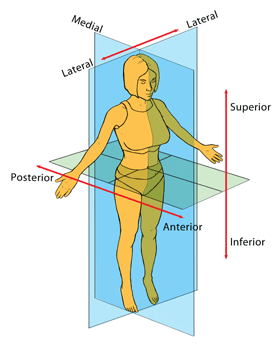
Superior aka Cephalad
Inferior aka Caudal
Anterior aka Ventral
Posterior aka Dorsal
Medial aka Internal
Lateral aka External
You may also come across terms that are used in more localized areas, such as distal (which means away from the core or trunk) and proximal (which means closer to the core or the trunk of the body). If we move into the body’s tissues we may come across terms like superficial (which means more towards the surface) and deep (which means more towards the center of the body.) While standing with our arms at our sides and the palms facing our thighs, we can pronate the hands – this means rotating the palms inward and backwards. Relative to the feet, pronation means to move the soles down and out. We can also supinate – this means rotating the palms forward (as shown in the model) or for the feet, turning the soles inward and up. Paul Grilley offers a simple way to remember when to say pronate and when to say supinate: if you want to become a “pro” basketball player, you have to learn to dribble, which requires you to turn your palms over towards the floor. That is how you become a pro – by pronating. However, if you are Oliver and you want more “supper” – you have to hold your bowl in your palms which have been supinated: “Please Sir, may I have more sup-per?”
This is not an exhaustive exploration of all the anatomical directions, but these will serve us well enough. If you want a more complete list of directional terms and body movements we have provided one here.
The most common directional terms we will come across in our yoga practice are flexion & extension, abduction & adduction, and internal & external rotation. These terms are applied to movements of the limbs with respect to each other or with respect to our axis, but we can apply these terms to a more limited degree to movements of the core of our body as well. Now that we know the three cardinal planes of the body and the directions we can move within these planes, we are ready to view these major movements.
Flexion & Extension
It is simpler to look at each plane of the body separately at first and define terms for the directions of motion possible. In the side plane, if we move an arm or a leg anteriorly (forward), that is termed flexion. If we move the limb posteriorly (backwards), that is termed extension.
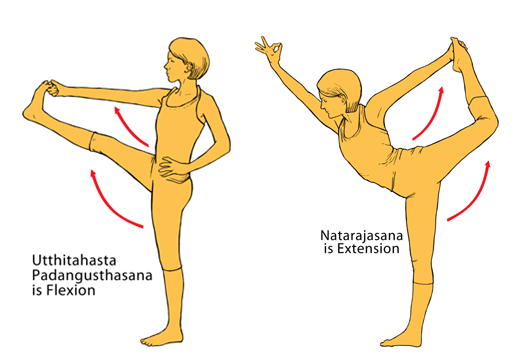
It may seem strange to use the term “flexion” to raising arms forward and up, but anatomically speaking that is what we do. Often a yoga teacher may instruct her class to “extend your arms up to the sky,” which is poetically correct, but not correct to an anatomist. Extension of the arms means a movement of the arms backwards. However, there are likely few anatomists in yoga classes, so most teachers can get away with saying “extend your arms up.” If you want to be more precise but still understood, you could change your instruction to “raise your arms to the sky.”
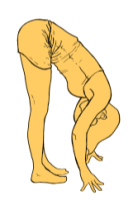
 For these two movements we kept the torso of the body still, but we could have chosen to keep the limbs still. If we bend the upper body forward, for example as shown in Uttanasana (aka Dangling Pose), this is also called flexion of the hips, and to a lesser degree of the spine, even though we have not moved the legs. If we bend the upper body backwards, as we do in Cobra or Sphinx Pose, this is still extension, this time of the spine and to a lesser degree of the hips.
For these two movements we kept the torso of the body still, but we could have chosen to keep the limbs still. If we bend the upper body forward, for example as shown in Uttanasana (aka Dangling Pose), this is also called flexion of the hips, and to a lesser degree of the spine, even though we have not moved the legs. If we bend the upper body backwards, as we do in Cobra or Sphinx Pose, this is still extension, this time of the spine and to a lesser degree of the hips.
Internal & External Rotations
 In the horizontal plane, when we rotate our limbs inwardly, it is called internal rotation, or sometimes we call it medial rotation. When we rotate our limbs outwardly, it is called external rotation, or lateral rotation. Stand in Mountain Pose and move your toes towards each other and heels apart: that is internal rotation of the femur in the hip socket. Move the toes away from each other and the heels together: that is external rotation.
In the horizontal plane, when we rotate our limbs inwardly, it is called internal rotation, or sometimes we call it medial rotation. When we rotate our limbs outwardly, it is called external rotation, or lateral rotation. Stand in Mountain Pose and move your toes towards each other and heels apart: that is internal rotation of the femur in the hip socket. Move the toes away from each other and the heels together: that is external rotation.
This can also occur in the arms as well: the humerus can rotate in the shoulder socket. In this graphic, we see internal and external rotation of the arm at the shoulder. If you stand with your arms raised to the side, elbows bent 90 degrees and palms facing the floor you are ready to experience these movements. Moving the hands up so the palms face forward, or even to the ceiling, is called external rotation. To experience internal rotation, start to lower your hands until the palms face backwards. Doing this simple exercise will give you some feel for how much range of motion you have for both internal and external rotation of your arms/shoulder.
We use external rotation when come into postures like the Wheel and Down Dog. Athletes also do this when they throw a ball: they first externally rotate their arm at the shoulder as much as possible (usually adding some extension of the spine to get more torque built up), and then flow into internal rotation as they move to throw the ball. We use internal rotation in postures where we bring the arm down and behind our back, such as in Cow Face or binding twists.
Below we see a yogi in the pose called The Goddess externally rotating her femurs in the hip socket and externally rotating her arms in the shoulders. We also see her internally rotating her legs in The Eagle posture, while maintaining an external rotation in the arms. It may be hard to understand why the arms are still externally rotated here because her arms are wrapped around themselves, but she has kept the external rotation shown in the Goddess and simply adducted the arms together, which brings us to the final two movements: abduction and adduction.
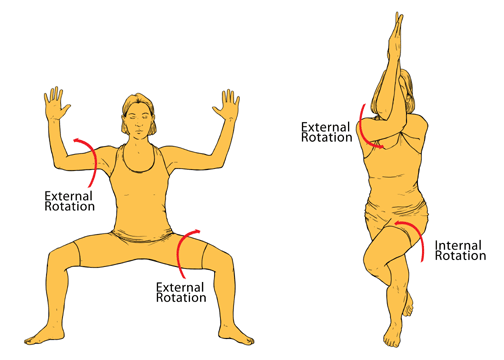
Abduction & Adduction
In the frontal plane, when we move limbs laterally, away from the body, it is called abduction, and when we move the limbs medially, towards the body, it is called adduction. Abduction is like kidnapping: we get abducted. Adduction is adding the parts of the body together. For the yogi standing in Goddess with arms and legs spread, the arms are abducted, as are the legs. This seems simple enough, but again we can hold the limbs still and move the torso. For example, consider the movements when we come into Triangle Pose: the top of the pelvis moves down towards the front leg, so this is also abduction! Any time the leg and the torso come closer together in the frontal plane, abduction occurs! Any time they move further apart, this is adduction. Don’t be confused by the fact that the legs are not moving closer together. What defines these movements is not the relationship of the legs to each other but their relationship to the pelvis or torso. Either the leg can move in abduction or the pelvis can move, but it is still abduction.
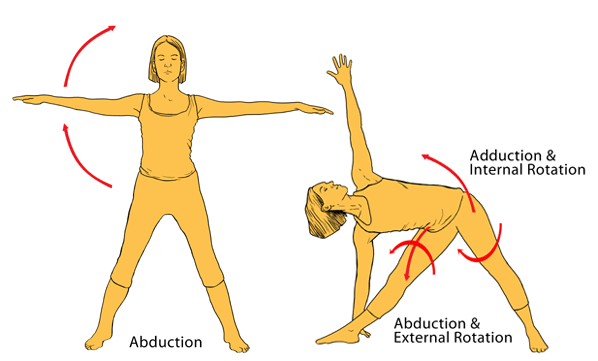
There is a lot more going on in Triangle Pose than just abduction of the front leg, however. There are other movements in the hip socket too, such as rotation, but the direction of this rotation depends upon which hip we are looking at. We will look at this in greater detail in our next article where we go deep into the hip socket and its ranges of movement, but for now, the graphic shows how in Triangle the front hip undergoes both abduction and external rotation while the back hip moves into adduction and internal rotation.
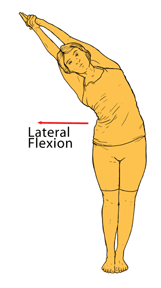 Another movement that can occur in the frontal plane is side flexion of the spine. If we move our torso left or right by moving our pelvis as shown above in Triangle, this is again a form of abduction at the hip socket, however if we flex only the spine, this is called “side flexion” or “lateral flexion” of the spine. A good example of lateral flexion is the Yin Yoga posture called Bananasana or the standard standing Half-Moon (aka Blown Palm or Ardha Chandrasana) shown here.
Another movement that can occur in the frontal plane is side flexion of the spine. If we move our torso left or right by moving our pelvis as shown above in Triangle, this is again a form of abduction at the hip socket, however if we flex only the spine, this is called “side flexion” or “lateral flexion” of the spine. A good example of lateral flexion is the Yin Yoga posture called Bananasana or the standard standing Half-Moon (aka Blown Palm or Ardha Chandrasana) shown here.
Putting It Altogether
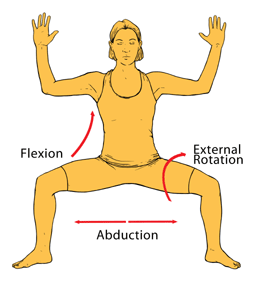 So far, so good we have looked at the simplest forms of flexion & extension, internal & external rotation, and abduction & adduction in the cases where the axis of the body is held still and the limbs move. Look again at the yogi in the Goddess: can you identify all the movements that have occurred here? It is a complicated movement but when we break it down into the 3D map of the body we find that there are simple movements in all three planes. For both arms and legs we find flexion, abduction and external rotation all occurring together!
So far, so good we have looked at the simplest forms of flexion & extension, internal & external rotation, and abduction & adduction in the cases where the axis of the body is held still and the limbs move. Look again at the yogi in the Goddess: can you identify all the movements that have occurred here? It is a complicated movement but when we break it down into the 3D map of the body we find that there are simple movements in all three planes. For both arms and legs we find flexion, abduction and external rotation all occurring together!
In yoga, however, we will often hold the limbs still and move the axis, as illustrated earlier in the Dangling Forward fold (Uttanasana) and the Triangle Pose. In these cases identifying the movements are more challenging. We will leave the investigation of these more challenging situations to when we look at the individual joints’ ranges of motion.
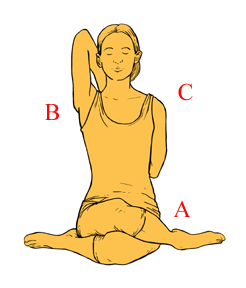 Time for a test to see how well you understand these directions. We will leave you with one last posture: Cowface (Gomukhasana) – it is up to you now to identify the movements occurring here at the hip (A) and the two shoulders (B & C). (You can visit this page for the answers.)
Time for a test to see how well you understand these directions. We will leave you with one last posture: Cowface (Gomukhasana) – it is up to you now to identify the movements occurring here at the hip (A) and the two shoulders (B & C). (You can visit this page for the answers.)
Hopefully with this basic understanding you can begin to understand how your body moves, and ultimately what prevents you from moving further in each of these directions. Knowing what we are doing helps us pay attention to what is possible and what limits we have reached.
